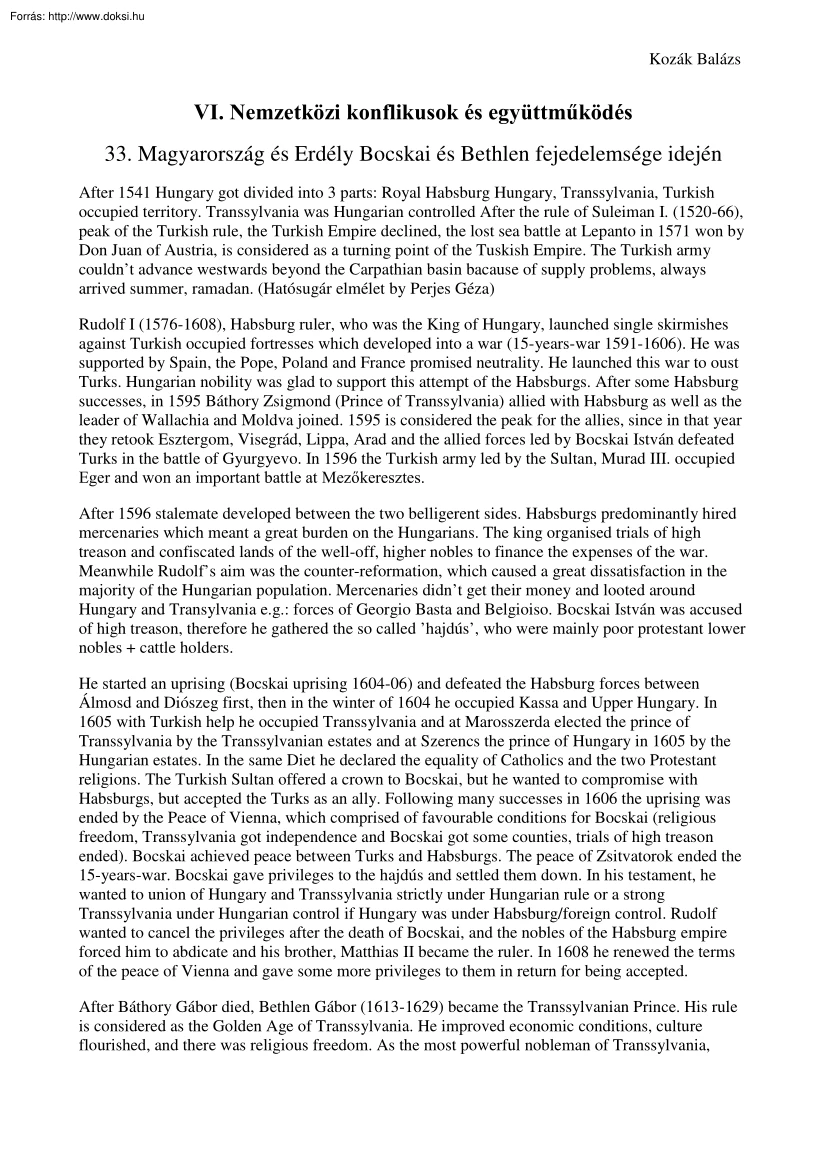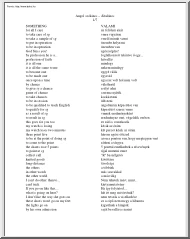Alapadatok
Év, oldalszám:2006, 2 oldal
Nyelv:magyar
Letöltések száma:47
Feltöltve:2010. augusztus 20.
Méret:66 KB
Intézmény:
-
Megjegyzés:
Csatolmány:-
Letöltés PDF-ben:Kérlek jelentkezz be!
Értékelések
Nincs még értékelés. Legyél Te az első!
Legnépszerűbb doksik ebben a kategóriában
Tartalmi kivonat
Kozák Balázs VI. Nemzetközi konflikusok és együttműködés 33. Magyarország és Erdély Bocskai és Bethlen fejedelemsége idején After 1541 Hungary got divided into 3 parts: Royal Habsburg Hungary, Transsylvania, Turkish occupied territory. Transsylvania was Hungarian controlled After the rule of Suleiman I (1520-66), peak of the Turkish rule, the Turkish Empire declined, the lost sea battle at Lepanto in 1571 won by Don Juan of Austria, is considered as a turning point of the Tuskish Empire. The Turkish army couldn’t advance westwards beyond the Carpathian basin bacause of supply problems, always arrived summer, ramadan. (Hatósugár elmélet by Perjes Géza) Rudolf I (1576-1608), Habsburg ruler, who was the King of Hungary, launched single skirmishes against Turkish occupied fortresses which developed into a war (15-years-war 1591-1606). He was supported by Spain, the Pope, Poland and France promised neutrality. He launched this war to oust Turks. Hungarian nobility was
glad to support this attempt of the Habsburgs After some Habsburg successes, in 1595 Báthory Zsigmond (Prince of Transsylvania) allied with Habsburg as well as the leader of Wallachia and Moldva joined. 1595 is considered the peak for the allies, since in that year they retook Esztergom, Visegrád, Lippa, Arad and the allied forces led by Bocskai István defeated Turks in the battle of Gyurgyevo. In 1596 the Turkish army led by the Sultan, Murad III occupied Eger and won an important battle at Mezőkeresztes. After 1596 stalemate developed between the two belligerent sides. Habsburgs predominantly hired mercenaries which meant a great burden on the Hungarians. The king organised trials of high treason and confiscated lands of the well-off, higher nobles to finance the expenses of the war. Meanwhile Rudolf’s aim was the counter-reformation, which caused a great dissatisfaction in the majority of the Hungarian population. Mercenaries didn’t get their money and looted around Hungary
and Transylvania e.g: forces of Georgio Basta and Belgioiso Bocskai István was accused of high treason, therefore he gathered the so called ’hajdús’, who were mainly poor protestant lower nobles + cattle holders. He started an uprising (Bocskai uprising 1604-06) and defeated the Habsburg forces between Álmosd and Diószeg first, then in the winter of 1604 he occupied Kassa and Upper Hungary. In 1605 with Turkish help he occupied Transsylvania and at Marosszerda elected the prince of Transsylvania by the Transsylvanian estates and at Szerencs the prince of Hungary in 1605 by the Hungarian estates. In the same Diet he declared the equality of Catholics and the two Protestant religions. The Turkish Sultan offered a crown to Bocskai, but he wanted to compromise with Habsburgs, but accepted the Turks as an ally. Following many successes in 1606 the uprising was ended by the Peace of Vienna, which comprised of favourable conditions for Bocskai (religious freedom, Transsylvania got
independence and Bocskai got some counties, trials of high treason ended). Bocskai achieved peace between Turks and Habsburgs The peace of Zsitvatorok ended the 15-years-war. Bocskai gave privileges to the hajdús and settled them down In his testament, he wanted to union of Hungary and Transsylvania strictly under Hungarian rule or a strong Transsylvania under Hungarian control if Hungary was under Habsburg/foreign control. Rudolf wanted to cancel the privileges after the death of Bocskai, and the nobles of the Habsburg empire forced him to abdicate and his brother, Matthias II became the ruler. In 1608 he renewed the terms of the peace of Vienna and gave some more privileges to them in return for being accepted. After Báthory Gábor died, Bethlen Gábor (1613-1629) became the Transsylvanian Prince. His rule is considered as the Golden Age of Transsylvania. He improved economic conditions, culture flourished, and there was religious freedom. As the most powerful nobleman of
Transsylvania, Kozák Balázs Bethlen used all means to unite the country. He realised that Turks still had considerable power therefore became a vassal state of Turks. Transsylvania was independent in home policy but in foreign policy she had to follow the instructions of the Turkish Empire as well as had to pay 10000 gold annually. The 30-years-war started seemingly as a religious war between Roman Catholics and Protestans in Bohemia, though the religion was only to camouflage the power rivalry, the opposition against Roman Catholic Habsburg absolute power and succession rivaly for the Bohemian throne. The initial religoius rivalry developed into a power rivaly between France and the Habsburgs, religion only became a camouflage. Bethlen Gábor joined the 30-years-war against Habsburgs. With the approval of the Sultan, he launched an attack on Upper Hungary. In 1620 August in the Diet of Besztercebánya he was elected Hungarian king, but he rejected this position, because he
didn’t feel himself strong enough. Though in 1620 autumn he had a successful campaign, he occupied the entire Transdanubia. Bohemian forces were defeated at White Mountain in 1620 November. He found himself alone without allies He levied high taxes in Hungary to finance further campaign, therefore Hungarian nobles turned away from him. He won some battles against the emperor in 1621 summer, but he had no foreign help, therefore made a peace with Ferdinand II. in 1621 at Nikolsburg He was given 7 counties and the privileges of 1606 and 1608 treaties were confirmed. Bethlen entered the 30-years-war 2 more times against the Habsburgs with not much success
glad to support this attempt of the Habsburgs After some Habsburg successes, in 1595 Báthory Zsigmond (Prince of Transsylvania) allied with Habsburg as well as the leader of Wallachia and Moldva joined. 1595 is considered the peak for the allies, since in that year they retook Esztergom, Visegrád, Lippa, Arad and the allied forces led by Bocskai István defeated Turks in the battle of Gyurgyevo. In 1596 the Turkish army led by the Sultan, Murad III occupied Eger and won an important battle at Mezőkeresztes. After 1596 stalemate developed between the two belligerent sides. Habsburgs predominantly hired mercenaries which meant a great burden on the Hungarians. The king organised trials of high treason and confiscated lands of the well-off, higher nobles to finance the expenses of the war. Meanwhile Rudolf’s aim was the counter-reformation, which caused a great dissatisfaction in the majority of the Hungarian population. Mercenaries didn’t get their money and looted around Hungary
and Transylvania e.g: forces of Georgio Basta and Belgioiso Bocskai István was accused of high treason, therefore he gathered the so called ’hajdús’, who were mainly poor protestant lower nobles + cattle holders. He started an uprising (Bocskai uprising 1604-06) and defeated the Habsburg forces between Álmosd and Diószeg first, then in the winter of 1604 he occupied Kassa and Upper Hungary. In 1605 with Turkish help he occupied Transsylvania and at Marosszerda elected the prince of Transsylvania by the Transsylvanian estates and at Szerencs the prince of Hungary in 1605 by the Hungarian estates. In the same Diet he declared the equality of Catholics and the two Protestant religions. The Turkish Sultan offered a crown to Bocskai, but he wanted to compromise with Habsburgs, but accepted the Turks as an ally. Following many successes in 1606 the uprising was ended by the Peace of Vienna, which comprised of favourable conditions for Bocskai (religious freedom, Transsylvania got
independence and Bocskai got some counties, trials of high treason ended). Bocskai achieved peace between Turks and Habsburgs The peace of Zsitvatorok ended the 15-years-war. Bocskai gave privileges to the hajdús and settled them down In his testament, he wanted to union of Hungary and Transsylvania strictly under Hungarian rule or a strong Transsylvania under Hungarian control if Hungary was under Habsburg/foreign control. Rudolf wanted to cancel the privileges after the death of Bocskai, and the nobles of the Habsburg empire forced him to abdicate and his brother, Matthias II became the ruler. In 1608 he renewed the terms of the peace of Vienna and gave some more privileges to them in return for being accepted. After Báthory Gábor died, Bethlen Gábor (1613-1629) became the Transsylvanian Prince. His rule is considered as the Golden Age of Transsylvania. He improved economic conditions, culture flourished, and there was religious freedom. As the most powerful nobleman of
Transsylvania, Kozák Balázs Bethlen used all means to unite the country. He realised that Turks still had considerable power therefore became a vassal state of Turks. Transsylvania was independent in home policy but in foreign policy she had to follow the instructions of the Turkish Empire as well as had to pay 10000 gold annually. The 30-years-war started seemingly as a religious war between Roman Catholics and Protestans in Bohemia, though the religion was only to camouflage the power rivalry, the opposition against Roman Catholic Habsburg absolute power and succession rivaly for the Bohemian throne. The initial religoius rivalry developed into a power rivaly between France and the Habsburgs, religion only became a camouflage. Bethlen Gábor joined the 30-years-war against Habsburgs. With the approval of the Sultan, he launched an attack on Upper Hungary. In 1620 August in the Diet of Besztercebánya he was elected Hungarian king, but he rejected this position, because he
didn’t feel himself strong enough. Though in 1620 autumn he had a successful campaign, he occupied the entire Transdanubia. Bohemian forces were defeated at White Mountain in 1620 November. He found himself alone without allies He levied high taxes in Hungary to finance further campaign, therefore Hungarian nobles turned away from him. He won some battles against the emperor in 1621 summer, but he had no foreign help, therefore made a peace with Ferdinand II. in 1621 at Nikolsburg He was given 7 counties and the privileges of 1606 and 1608 treaties were confirmed. Bethlen entered the 30-years-war 2 more times against the Habsburgs with not much success





 Ahogy közeledik a történelem érettségi, sokan döbbennek rá, hogy nem készültek fel eléggé az esszéírás feladatra. Módszertani útmutatónkban kitérünk a történet térbeli és időbeli elhelyezésére, a források elemzésére és az eseményeket alakító tényezőkre is.
Ahogy közeledik a történelem érettségi, sokan döbbennek rá, hogy nem készültek fel eléggé az esszéírás feladatra. Módszertani útmutatónkban kitérünk a történet térbeli és időbeli elhelyezésére, a források elemzésére és az eseményeket alakító tényezőkre is.